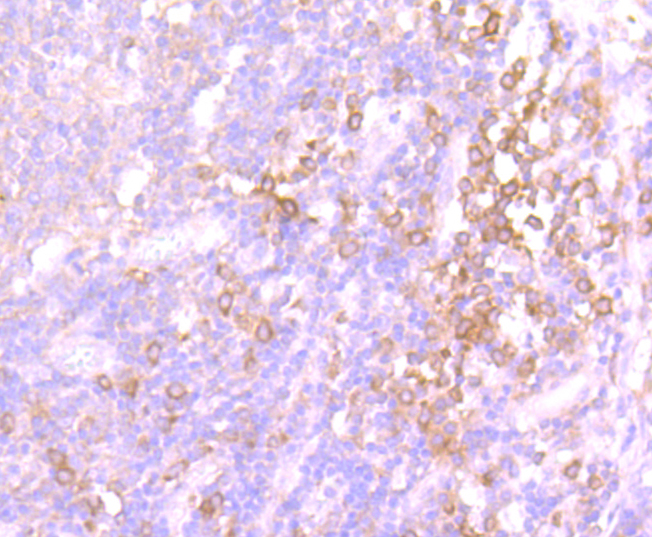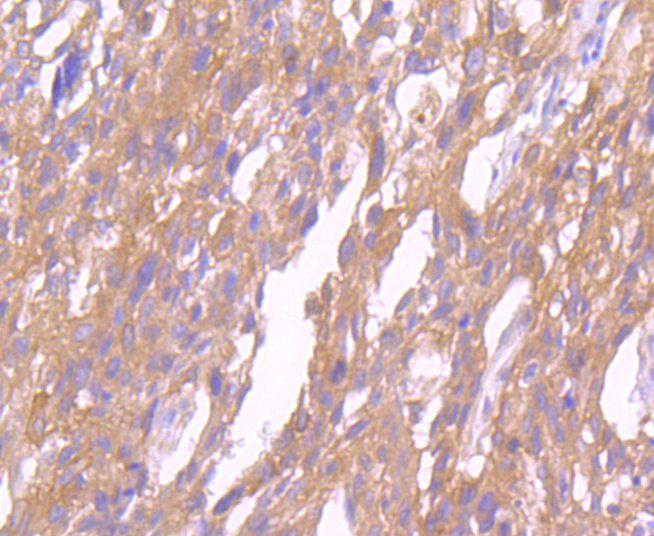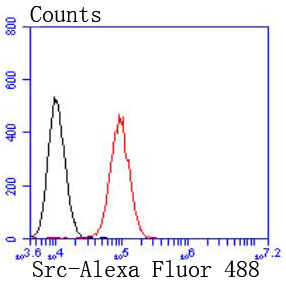Product Detail
Product NameSrc Rabbit mAb
Clone No.JF0947
Host SpeciesRecombinant Rabbit
Clonality Monoclonal
PurificationProA affinity purified
ApplicationsWB, ICC/IF, IHC, FC
Species ReactivityHu, Ms, Rt
Immunogen Descrecombinant protein
ConjugateUnconjugated
Other NamesASV antibody Avian sarcoma virus antibody c SRC antibody CDNA FLJ14219 fis clone NT2RP3003800 highly similar to Rattus norvegicus tyrosine protein kinase pp60 c src mRNA antibody cSrc antibody EC 2.7.10.2 antibody Neuronal CSRC tyrosine specific protein kinase antibody Neuronal SRC antibody Oncogene SRC antibody OTTHUMP00000174476 antibody OTTHUMP00000174477 antibody p60 Src antibody p60-Src antibody p60Src antibody pp60c src antibody pp60c-src antibody pp60csrc antibody Proto oncogene tyrosine protein kinase Src antibody Proto-oncogene c-Src antibody Proto-oncogene tyrosine-protein kinase Src antibody Protooncogene SRC antibody Protooncogene SRC Rous sarcoma antibody Src antibody SRC Oncogene antibody SRC proto oncogene non receptor tyrosine kinase antibody SRC_HUMAN antibody SRC1 antibody Tyrosine kinase pp60c src antibody Tyrosine protein kinase SRC 1 antibody Tyrosine protein kinase SRC1 antibody v src avian sarcoma (Schmidt Ruppin A2) viral oncogene homolog antibody V src sarcoma (Schmidt Ruppin A 2) viral oncogene homolog (avian) antibody v src sarcoma (Schmidt Ruppin A 2) viral oncogene homolog avian antibody
Accession NoSwiss-Prot#:P12931
Uniprot
P12931
Gene ID
6714;
Calculated MW60 kDa
Formulation1*TBS (pH7.4), 1%BSA, 40%Glycerol. Preservative: 0.05% Sodium Azide.
StorageStore at -20˚C
Application Details
WB: 1:1,000-5,000
IHC: 1:50-1:200
ICC: 1:100-1:500
FC: 1:50-1:100
Western blot analysis of Src on HUVEC cells lysates using anti-Src antibody at 1/1,000 dilution.
Immunohistochemical analysis of paraffin-embedded human tonsil tissue using anti-Src antibody. Counter stained with hematoxylin.
Immunohistochemical analysis of paraffin-embedded human breast carcinoma tissue using anti-Src antibody. Counter stained with hematoxylin.
Immunohistochemical analysis of paraffin-embedded human kidney tissue using anti-Src antibody. Counter stained with hematoxylin.
Immunohistochemical analysis of paraffin-embedded rat brain tissue using anti-Src antibody. Counter stained with hematoxylin.
Immunohistochemical analysis of paraffin-embedded mouse kidney tissue using anti-Src antibody. Counter stained with hematoxylin.
ICC staining Src in Hela cells (green). The nuclear counter stain is DAPI (blue). Cells were fixed in paraformaldehyde, permeabilised with 0.25% Triton X100/PBS.
ICC staining Src in MCF-7 cells (green). The nuclear counter stain is DAPI (blue). Cells were fixed in paraformaldehyde, permeabilised with 0.25% Triton X100/PBS.
ICC staining Src in A431 cells (green). The nuclear counter stain is DAPI (blue). Cells were fixed in paraformaldehyde, permeabilised with 0.25% Triton X100/PBS.
Flow cytometric analysis of NIH/3T3 cells with Src antibody at 1/50 dilution (red) compared with an unlabelled control (cells without incubation with primary antibody; black). Alexa Fluor 488-conjugated goat anti rabbit IgG was used as the secondary antibody
The major translational products of the Src gene family are membrane-associated tyrosine protein kinases that lack transmembrane and external amino acid sequences. By virtue of their common structural motifs, the Src family is composed of nine members in vertebrates, including c-Src, c-Yes, Fgr, Yrk, Fyn, Lyn, Hck, Lck and Blk. Src family kinases, which contain an amino-terminal cell membrane anchor followed by SH3 and SH2 domains, transduce signals that are involved in the control of a variety of cellular processes, including proliferation, differentiation, motility and adhesion. Src family members are normally maintained in an inactive state and can be activated transiently during cellular events such as mitosis. Different subcellular locations of Src family kinases may be important for the regulation of specific cellular processes, such as mitogenesis, cytoskeletal organization and membrane trafficking. c-Src (also designated pp60Src, Src p60 and proto-oncogene tyrosine protein kinase Src) is expressed in a broad range of tissue and cell types, although the highest levels of c-Src are detected in neuronal tissues and platelets. c-Src may play a role in events associated with both neuronal differentiation and maintenance of mature neuronal cell functions.
If you have published an article using product 49317, please notify us so that we can cite your literature.












 Yes
Yes



